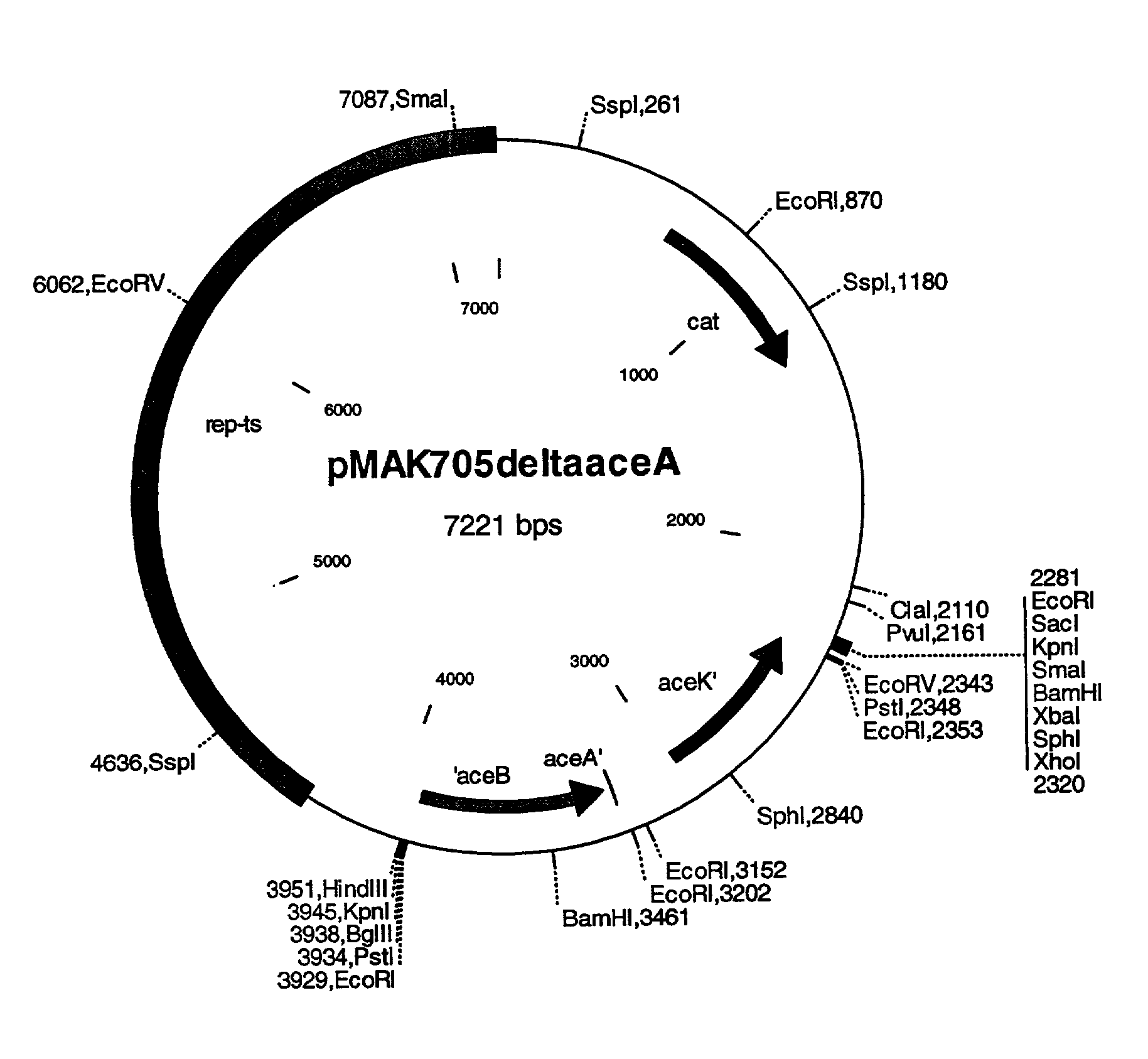Process for the production of L-amino acids using strains of the family enterobacteriaceae that contain an attenuated aceA gene
a technology of enterobacteriaceae and gene, which is applied in the field of process for the production of lamino acids using strains of the family enterobacteriaceae, can solve the problems of incomplete disruption of enzyme activity, false amino acid incorporation or premature termination of translation, and complete disruption of enzyme activity
- Summary
- Abstract
- Description
- Claims
- Application Information
AI Technical Summary
Problems solved by technology
Method used
Image
Examples
example 2
Construction of the Exchange Vector pMAK705.DELTA.aceA
[0085] The aceBAK allele described in Example 1 is isolated from the vector pCR2.1TOPO.DELTA.aceA after restriction with the enzymes HindIIi and XbaI and separation in 0.8% agarose gel, and is ligated with the plasmid pMAK705 (Hamilton et al. (1989) Journal of Bacteriology 171, 4617-4622), that had been digested with the enzymes HindIII and XbaI. The ligation batch is transformed in DH5.alpha. and plasmid-carrying cells are selected on LB agar to which 20 .mu.g / ml of chloramphenicol have been added. The successful cloning is detected after plasmid DNA isolation and cleavage with the enzymes BamHI, KpnI, SphI, SpeI and PstI. The resultant exchange vector pMAK705.DELTA.aceA (=pMAK705deltaaceA) is shown in FIG. 1.
example 3
Site-specific Mutagenesis of the aceA Gene in the E. coli Strain MG442
[0086] The E. coli
[0087] strain MG442 producing L-threonine is described in patent specification U.S. Pat. No. 4,278,765 and is filed as CMIM B-1628 at the Russian National Collection for Industrial Microorganisms (VKPM, Moscow, Russia).
[0088] For the exchange of the chromosomal aceA gene by the plasmid-coded deletion construct, MG442 is transformed with the plasmid pMAK705AaceA. The gene exchange is carried out by the selection process described by Hamilton et al. (1989) Journal of Bacteriology 171, 4617-4622) and is verified by standard PCR methods (Innis et al. (1990) PCR Protocols. A guide to methods and applications, Academic Press) with the following oligonucleotide primers:
4 aceA'5'-1: 5'-ATGCTTACTCACGCCTGTTG-3' (SEQ ID No.3) aceA'3'-2: 5'-CAGTTCGTTCGCCACCTGTA-3' (SEQ ID No.6)
example 4
Production of L-threonine Using the Strain MG442.DELTA.aceA
[0089] MG442AaceA is cultivated on minimal medium having the following composition: 3.5 g / l Na.sub.2HPO.sub.4.2H.sub.2O, 1.5 g / l KH.sub.2PO.sub.4, 1 g / l NH.sub.4Cl, 0.1 g / l MgSO.sub.4.7H.sub.2O, 2 g / l glucose and 20 g / l agar. The formation of L-threonine is checked in batch cultures of 10 ml that are contained in 100 ml Erlenmeyer flasks. For this, 10 ml of preculture medium of the following composition: 2 g / l yeast extract, 10 g / l (NH.sub.4).sub.2SO.sub.4, 1 g / l KH.sub.2PO.sub.4, 0.5 g / l MgSO.sub.4.7H.sub.2O, 15 g / l CaCO.sub.3, 20 g / l glucose are inoculated and incubated for 16 hours at 37.degree. C. and 180 rpm in an ESR incubator from Kuthner AG (Birsfelden, Switzerland). 250 .mu.l of this preculture are reinoculated in 10 ml of production medium (25 g / l (NH.sub.4).sub.2SO.sub.4, 2 g / l KH.sub.2PO.sub.4, 1 g / l MgSO.sub.4.7H.sub.2O, 0.03 g / l FeSO.sub.4.7H.sub.2O, 0.018 g / l MnSO.sub.4.1H.sub.2O, 30 g / l CaCO.sub.3 and 20 g / l ...
PUM
| Property | Measurement | Unit |
|---|---|---|
| temperature | aaaaa | aaaaa |
| temperature | aaaaa | aaaaa |
| temperatures | aaaaa | aaaaa |
Abstract
Description
Claims
Application Information
 Login to View More
Login to View More - R&D
- Intellectual Property
- Life Sciences
- Materials
- Tech Scout
- Unparalleled Data Quality
- Higher Quality Content
- 60% Fewer Hallucinations
Browse by: Latest US Patents, China's latest patents, Technical Efficacy Thesaurus, Application Domain, Technology Topic, Popular Technical Reports.
© 2025 PatSnap. All rights reserved.Legal|Privacy policy|Modern Slavery Act Transparency Statement|Sitemap|About US| Contact US: help@patsnap.com

